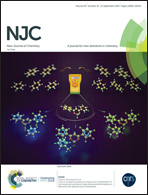Poly(ester amide) derived from municipal polyethylene terephthalate waste guided stem cells for osteogenesis†
Abstract
In spite of the recent progress in the field of tissue engineering, there is still a lack of suitable biomaterials due to the high cost and difficult synthesis procedures of biopolymers. To address this problem, herein, we have developed a bioresorbable poly(ester amide) using soybean oil and a monomer bis(2-hydroxyethyl)terephthalamide (BHETA) derived from recycled poly(ethylene terephthalate) waste (PET) and other low cost renewable resources, such as citric acid, sebacic acid and mannitol, by a simple solvent and catalyst-free melt polycondensation reaction. A series of polymers were synthesized by altering the monomer feed ratio and the synthesis was confirmed by FTIR spectroscopy, NMR spectroscopy, TGA, DSC, XRD, etc. The synthesized poly(ester amide) showed excellent cytocompatibility against mouse embryonic stem cells (OP9) with tunable mechanical properties along with a degradation rate that depended on the monomer feed ratio. Interestingly, the poly(ester amide) guided the differentiation of stem cells towards osteogenesis rather than chondrogenesis, although the extent of osteogenesis depended on the monomer feed ratio. The formation of bone minerals was confirmed by alizarin red assay, SEM and EDAX study. Therefore, the synthesized poly(ester amide) may be a potential alternative low-cost biopolymer for bone tissue engineering applications in future.



 Please wait while we load your content...
Please wait while we load your content...